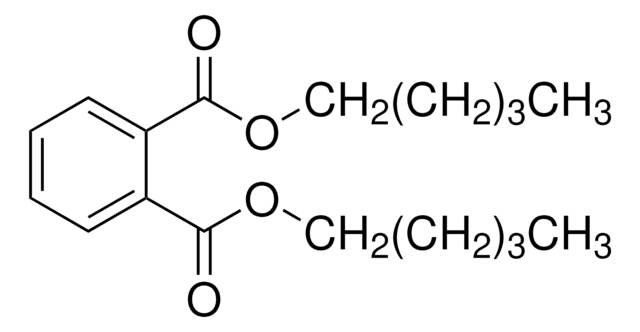31301
Di-n-octyl phthalate
analytical standard
Synonym(s):
DNOP, Phthalic acid di-n-octyl ester
About This Item
Recommended Products
grade
analytical standard
Quality Level
shelf life
limited shelf life, expiry date on the label
technique(s)
HPLC: suitable
gas chromatography (GC): suitable
density
0.980 g/mL at 20 °C (lit.)
application(s)
cleaning products
cosmetics
food and beverages
personal care
format
neat
SMILES string
CCCCCCCCOC(=O)c1ccccc1C(=O)OCCCCCCCC
InChI
1S/C24H38O4/c1-3-5-7-9-11-15-19-27-23(25)21-17-13-14-18-22(21)24(26)28-20-16-12-10-8-6-4-2/h13-14,17-18H,3-12,15-16,19-20H2,1-2H3
InChI key
MQIUGAXCHLFZKX-UHFFFAOYSA-N
Looking for similar products? Visit Product Comparison Guide
General description
Application
- Soil samples using micellar electro-kinetic chromatography (MEKC), further confirmed by gas chromatography with flame ionization detection (GC-FID).
- Bottled water using gas chromatography coupled to mass spectrometry (GC-MS).
- Plastic toys using gas chromatography with flame ionization detection (GC-FID).
Hazard Statements
Precautionary Statements
Hazard Classifications
Aquatic Chronic 4
Storage Class Code
10 - Combustible liquids
WGK
WGK 1
Flash Point(F)
228.2 °F - closed cup
Flash Point(C)
109.0 °C - closed cup
Personal Protective Equipment
Choose from one of the most recent versions:
Already Own This Product?
Find documentation for the products that you have recently purchased in the Document Library.
Customers Also Viewed
Articles
A sensitive, quantitative, and reproducible SPME-GC/MS procedure was developed by Supelco for the extraction of phthalate esters from oily food matrices, such as the flavored oils included with ramen noodle kits.
Our team of scientists has experience in all areas of research including Life Science, Material Science, Chemical Synthesis, Chromatography, Analytical and many others.
Contact Technical Service


